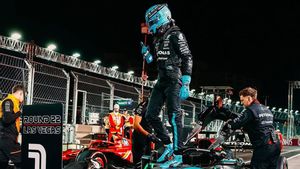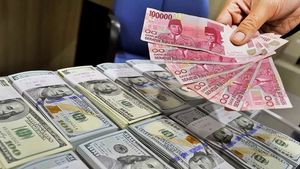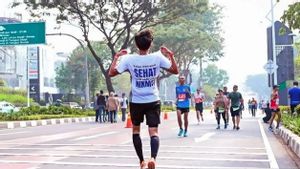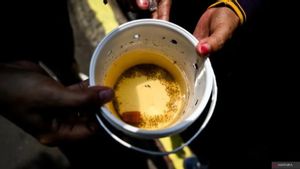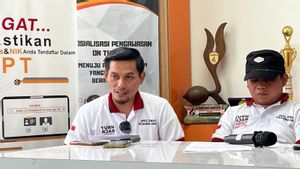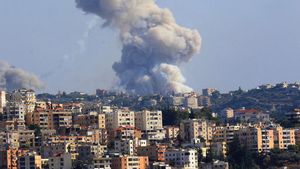JAKARTA - The pedicab driver was once considered a benulu for the development of Jakarta. The presence of a rickshaw at the estuary of Jakarta is associated with poverty. Moreover, the presence of pedicab drivers for the DKI Jakarta government has difficulty presenting modern public transportation.
Ali Sadikin was furious. The governor of DKI Jakarta 1966-1977 perpetuated efforts to clean up pedicab drivers. From prohibiting the manufacture of new rickshaws to arrest the owner of rickshaws. All of this is to build Jakarta as a Metropolitan City.
The city of Jakarta has never lost its appeal. In fact, since the Dutch colonial period. Jakarta, which at that time was named Batavia, became the goal of many people's lives. From the Dutch to Chinese. The assumption is that there are many jobs available, so the reason is.
All because Batavia is known to be very massive as a field of spice business. Even as a city where various ethnic groups come and are children. In fact, it lasted until Indonesia became independent.
Jakarta remains one of the special cities in the archipelago. All kinds of important historical events occurred in Jakarta. From the Youth Pledge, the birth of Pancasila, to the Proclamation of Indonesian Independence. This condition was legitimized by the election of Jakarta as the capital city of the country.
The status of the capital city made many people from various parts of the archipelago come to try their luck. At first, they brought their relatives for a long time. However, not everyone who came to Jakarta was blessed with qualified skills.
Most of them are trapped working rough and their lives end up as homeless people. The pedicab driver, for example. The profession is considered to have a bad influence on Jakarta. The pedicab driver is considered a profession that obscures the number of homeless people in Jakarta. Moreover, pedicab drivers are considered to have contributed to Jakarta's image, which is closely associated with poverty. Ali Sadikin was furious.
This dam needs to be done. Jakarta itself is already so dense, and it is difficult to get housing in this capital city. Some of the residents outside the capital came to Jakarta to look for work. Arriving in Jakarta they turned out to be unable to do anything, found no work, and finally became homeless.
"In that case, there are indeed some of them who can find work, as pedicab drivers and similar, but they did not find a shelter, and in the end they became doubles as well. In short, the word homeless people in the capital city is a serious problem. The amount is huge," said Ali Sadikin as written by Ramadhan KH in the book Bang Ali: For the sake of Jakarta 1966-1977 (1992).
The anger of the Governor of DKI Jakarta, Ali Sadikin against the pedicab, reasoned. The firm figure said the pedicab driver had brought serious problems to Jakarta. The pedicab driver is considered the culprit of traffic jams. Sometimes also referred to as an inhumane job.
Moreover, the profession as a pedicab driver is in fact able to bring in many people outside Jakarta to stay and become homeless. All because there are no special criteria to become a pedicab driver. Anyone who is physically healthy can become a pedicab driver.
This condition is considered to hamper the development of modern transportation in Jakarta. Ali Sadikin also tried to provide a solution. He launched a rickshaw cleaning operation in 1970. The operation was perpetuated so that the profession as a pedicab driver was immediately abandoned. Also as a warning to immigrants to prefer to live in the village rather than to Jakarta.
The cleaning operation is not smooth. There are many challenges. Likewise, about it. At that time, rickshaw transportation had become the prima donna among the people of Jakarta. Especially for those who live in Jakarta villages.
The rickshaw can go in and out of the village easily, unlike public transportation such as buses. Those efforts also received pros and cons, especially among pedicab drivers, which at that time reached hundreds of thousands of people.
However, Ali Sadikin didn't care. He considered his idea to be for survival in the Metropolitan City and to eradicate all kinds of slums. The operation to clean up the rickshaw was strengthened by the issuance of Regional Regulation No. 4 of 1972.
The regulation confirms that the rickshaw is not like a road in Jakarta. The cleaning of the rickshaw continues even though Ali Sadikin is no longer in office until Jakarta is completely free from rickshaws.
In 1970, there were 92,650 rickshaws officially registered in Jakarta; unofficially the number is estimated at 150 thousand. The rickshaws that are touched at least in two turns each day provide jobs for about 300 thousand people who are conservatively estimated to support 900 thousand others.
So, about 1.2 million people's lives depend on the rickshaw. As a first step to removing the rickshaw, in 1970 Ali Sadikin banned the manufacture of new rickshaws. A year later, he began to limit the areas of rickshaw operations. The police raided rickshaws in the area and confiscated their vehicles," said Susan Blackburn in the bookJakarta: History 400 Years (2011).
The English, Chinese, Japanese, Arabic, and French versions are automatically generated by the AI. So there may still be inaccuracies in translating, please always see Indonesian as our main language. (system supported by DigitalSiber.id)



